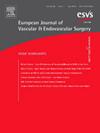Pre-clinical Evaluation of a New Generation Bridging Stent for Fenestrated Endovascular Aneurysm Repair Using Realistic 3D Printed Aneurysm Models
IF 5.7
1区 医学
Q1 PERIPHERAL VASCULAR DISEASE
European Journal of Vascular and Endovascular Surgery
Pub Date : 2025-06-01
DOI:10.1016/j.ejvs.2025.01.027
引用次数: 0
Abstract
Objective
The aim of this study was to perform a comparative pre-clinical evaluation of a new fenestrated endovascular aneurysm repair dedicated stent using perfused 3D printed patient anatomies.
Methods
The test setup included a pulsatile pump set to reproduce human haemodynamics, four 3D printed pararenal aneurysms connected to a bench test, and four corresponding fenestrated grafts (Zenith Fenestrated; Cook, Bloomington, IN, USA). Bridging stents were sized based on analysis of patients computed tomography scans and included either four standard covered stents (BeGraft [BG]; Bentley, Hechingen, Germany) or four similar covered stent grafts mounted on a modified balloon to allow stent implantation and flaring in one step (BeFlared [BF]; Bentley). Each anatomy and corresponding endograft was used for four sets of four bridging stent implantations. Selective angiography following each stent implantation was used to assess efficacy (patency and absence of type Ic or IIIc endoleak), procedure time was recorded, and cone beam computed tomography at the end of each set of four stent implantations enabled comparison of geometric layout between stents. Physician assessment evaluated technical performance and failure modes.
Results
Sixty four stents were successfully implanted. Selective angiograms depicted three type IIIc (two in BG, one in BF) and seven type Ic (four in BG, three in BF) endoleaks, which were all corrected intra-operatively. Compared with BG, the BF had a larger mean proximal diameter inside the endograft (10.5 mm vs. 9.2 mm; p < .001) and greater opening flaring angle (46.1° vs. 33.4°; p < .001). The eight procedures performed with the BF were quicker than BG (17.0 ± 4 minutes vs. 23.9 ± 4.7 minutes; p = .004). Physician assessment did not reveal any failure mode and concluded an excellent technical performance of both devices.
Conclusion
The BF demonstrated similar efficacy and performance compared with the BG for bridging target vessels in an innovative test setup using 3D printed patient anatomies.
新一代桥式支架用于开窗腔内动脉瘤修复的临床前评估
目的:本研究的目的是利用灌注3D打印患者解剖结构对一种新型开窗血管内动脉瘤修复专用支架进行临床前比较评估。方法:试验装置包括一个用于复制人体血流动力学的脉动泵,四个3D打印的动脉瘤连接到一个台架试验,以及四个相应的开窗移植物(Zenith feneated;Cook, Bloomington, IN, USA)。架桥支架的大小根据患者的计算机断层扫描结果进行分析,包括四个标准覆盖支架(BeGraft [BG];Bentley, Hechingen, Germany)或四个类似的覆盖支架移植物,安装在一个改良的球囊上,使支架植入和扩张一步完成(be喇叭[BF];宾利)。每个解剖和相应的内移植物用于4组4个桥式支架植入。每次支架植入后采用选择性血管造影来评估疗效(Ic/IIIc型血管渗漏的通畅和缺失),记录手术时间,并在每组四次支架植入结束时进行锥束计算机断层扫描,以比较支架之间的几何布局。医师评估评估了技术性能和失效模式。结果:成功植入64个支架。选择性血管造影显示3例IIIc型(2例BG, 1例BF)和7例Ic型(4例BG, 3例BF)内漏,均术中纠正。与BG相比,BF在移植物内的平均近端直径更大(10.5 mm比9.2 mm;P < 0.001)和更大的张开角(46.1°vs. 33.5°;P < 0.001)。使用BF进行的8项手术均快于BG(17.0±4分钟vs. 23.9±4.7分钟);P = .004)。医师评估未发现任何失效模式,并总结了两种设备的优秀技术性能。结论:在使用3D打印患者解剖结构的创新测试装置中,与BG相比,BF在桥接目标血管方面表现出相似的功效和性能。
本文章由计算机程序翻译,如有差异,请以英文原文为准。
求助全文
约1分钟内获得全文
求助全文
来源期刊
CiteScore
6.80
自引率
15.80%
发文量
471
审稿时长
66 days
期刊介绍:
The European Journal of Vascular and Endovascular Surgery is aimed primarily at vascular surgeons dealing with patients with arterial, venous and lymphatic diseases. Contributions are included on the diagnosis, investigation and management of these vascular disorders. Papers that consider the technical aspects of vascular surgery are encouraged, and the journal includes invited state-of-the-art articles.
Reflecting the increasing importance of endovascular techniques in the management of vascular diseases and the value of closer collaboration between the vascular surgeon and the vascular radiologist, the journal has now extended its scope to encompass the growing number of contributions from this exciting field. Articles describing endovascular method and their critical evaluation are included, as well as reports on the emerging technology associated with this field.

 求助内容:
求助内容: 应助结果提醒方式:
应助结果提醒方式:


